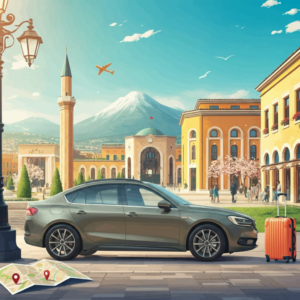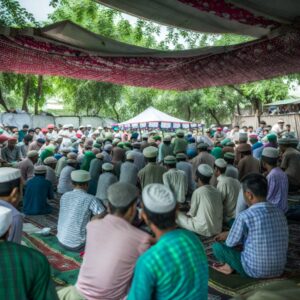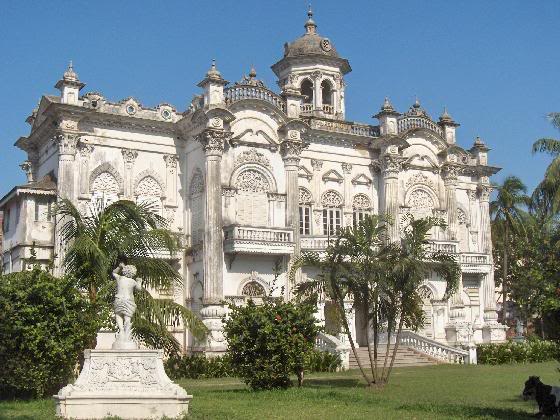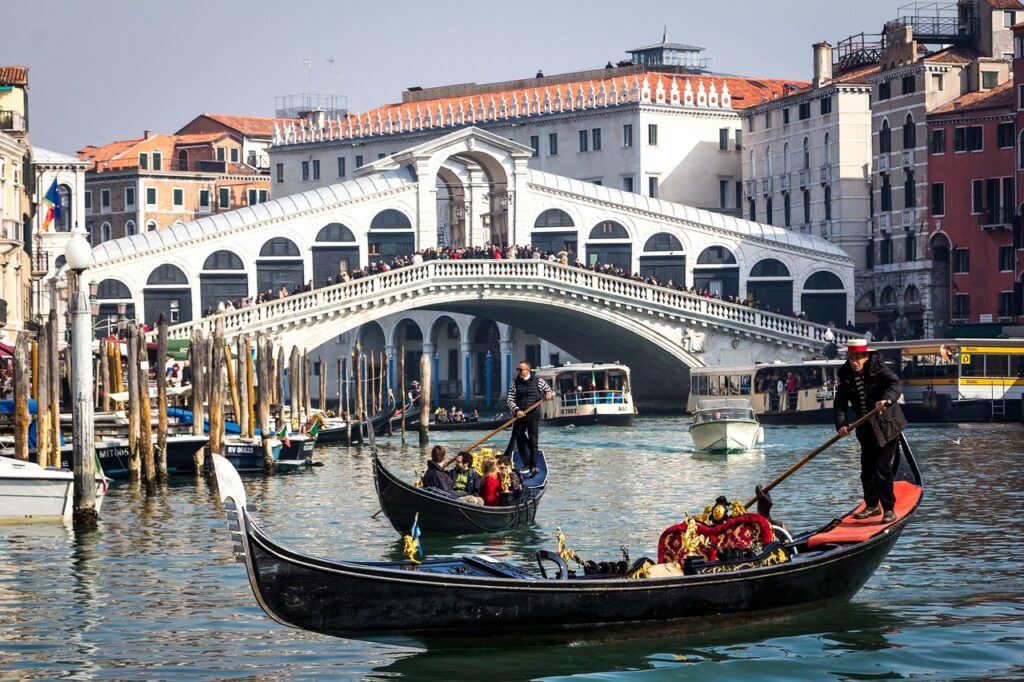Dhaka, the capital city of Bangladesh, is a melting pot of rich history, diverse cultures, and architectural grandeur. As one of the most vibrant and oldest cities in South Asia, Dhaka boasts a wide array of heritage sites that have witnessed the evolution of the city over centuries. These sites not only reflect the region’s historical and aesthetic significance but also stand as symbols of its social, cultural, religious, and political transformations. From Mughal-era mosques to colonial buildings and modern-day landmarks, Dhaka’s heritage offers a deep insight into its diverse past. This list of 100 heritage sites, including those established within the last century, showcases the multi-layered identity of Dhaka, emphasizing that a site’s historical importance isn’t always determined by age but by its continued relevance and impact on the people and culture of the city.
-
Binat Bibi Mosque
-
Established: 17th century during the Mughal era.
-
Founder: Unknown, but attributed to the Mughal period.
-
Main Attraction: This mosque is notable for its historical significance and its role in religious practices.
-
Specification: Features traditional Mughal architecture, including arches and intricate tilework.
-
Location: Located in the old part of Dhaka, near the Lalbagh Fort complex.
-
-
Bara Katra
-
Established: 1644 during the Mughal era.
-
Founder: Mir Jumla, a Mughal general.
-
Main Attraction: A caravanserai that served as a resting place for merchants.
-
Specification: The building is made with red brick and features a large courtyard with arcades.
-
Location: Located in the Chawkbazar area of Old Dhaka.
-
-
Chhoto Katra
-
Established: Mid-17th century, around 1660.
-
Founder: Mir Jumla, similar to Bara Katra.
-
Main Attraction: A smaller version of Bara Katra, known for its beautiful architecture.
-
Specification: Displays classic Mughal architectural style with intricate plaster work and arches.
-
Location: Near the Nimtali area in Old Dhaka.
-
-
Lalbagh Fort Complex
-
Established: 1678.
-
Founder: Prince Muhammad Azam, son of Mughal Emperor Aurangzeb.
-
Main Attraction: The fort’s unfinished state gives it a unique charm, and its gardens, mosque, and tomb are major attractions.
-
Specification: Features Mughal architecture, with beautiful gardens, an imposing gateway, and a historic mosque.
-
Location: Situated in the Lalbagh area of Old Dhaka.
-
-
Nimtoli Dewri
-
Established: Early 18th century.
-
Founder: Built during the Mughal period as an entryway to Nimtoli.
-
Main Attraction: Known for its architectural grandeur and its role in Dhaka’s urban planning.
-
Specification: The gate features Mughal-style arches and carvings.
-
Location: Located in Old Dhaka near the main road leading to the Lalbagh Fort.
-
-
Kartalab Khan Mosque
-
Established: 17th century.
-
Founder: Kartalab Khan, a Mughal official.
-
Main Attraction: Known for its historical importance and religious role.
-
Specification: It has a simple but elegant structure with a traditional mosque design and large dome.
-
Location: Situated in the Chawkbazar area of Old Dhaka.
-
-
Khan Muhammad Mirdha Mosque
-
Established: 17th century.
-
Founder: Khan Muhammad Mirdha, a Mughal noble.
-
Main Attraction: The mosque is noted for its beautiful traditional Mughal architecture.
-
Specification: A small mosque with detailed brickwork and an impressive dome.
-
Location: Located near the Lalbagh Fort in Old Dhaka.
-
-
Shaista Khan Mosque
-
Established: Early 17th century.
-
Founder: Shaista Khan, the Mughal Subahdar of Bengal.
-
Main Attraction: Known for its historical significance as a place of worship during the Mughal rule.
-
Specification: Features a classic Mughal structure with domes and a large prayer hall.
-
Location: Situated in the old town near the Lalbagh area.
-
-
Gol Talab (Pond)
-
Established: Mughal period (exact date unknown).
-
Founder: Unknown, but likely constructed during the Mughal era.
-
Main Attraction: A large pond in the midst of Old Dhaka that was once used for various purposes, including water supply.
-
Specification: The pond is circular and is an important example of water management systems of the Mughal era.
-
Location: Located in the Chawkbazar area of Old Dhaka.
-
-
Buckland Bundh
-
Established: Early 19th century during British colonial rule.
-
Founder: Named after a British official, possibly related to early British colonial activities in Dhaka.
-
Main Attraction: Known for its engineering and water management history.
-
Specification: A water reservoir used for drainage and water storage.
-
Location: Located near the Bongo Bazar area in Old Dhaka.
-
Christian Cemetery
-
Established: 18th century during British rule.
-
Founder: Christian missionaries and British settlers.
-
Main Attraction: The cemetery reflects Dhaka’s colonial and religious history, with several old tombstones.
-
Specification: A peaceful cemetery with historical tombstones from the British era.
-
Location: Situated in the Wari area of Dhaka.
-
Hosaini Dalan
-
Established: 17th century.
-
Founder: Built by the Shia Muslim community.
-
Main Attraction: A key religious site for observing Muharram and other Shia rituals.
-
Specification: It includes a mosque, a hall, and a religious courtyard.
-
Location: Located in the older parts of Dhaka, near Chawkbazar.
-
Dhakeshwari Temple
-
Established: 12th century.
-
Founder: King Ballal Sen, a Hindu ruler.
-
Main Attraction: This temple is a central part of Dhaka’s Hindu heritage.
-
Specification: The temple has traditional Hindu architectural elements, with a beautiful spire and a serene ambiance.
-
Location: Located in the Dhakeshwari area of Dhaka, near the heart of the city.
-
Joykali Temple
-
Established: 17th century.
-
Founder: The temple was built by local Hindu devotees.
-
Main Attraction: It is one of the oldest temples in Dhaka, dedicated to Goddess Kali.
-
Specification: A beautifully decorated Hindu temple with strong local and cultural significance.
-
Location: Situated in the Shankhari Bazar area of Old Dhaka.
-
Ram Sita Temple
-
Established: Exact date unknown, but dates back several centuries.
-
Founder: Hindu community in Dhaka.
-
Main Attraction: Dedicated to Lord Rama and Goddess Sita, the temple is a significant part of Dhaka’s Hindu community.
-
Specification: Features a simple yet elegant design with beautiful idols and religious sculptures.
-
Location: Located in the Sutrapur area of Dhaka.
-
Armenian Church
-
Established: 1781.
-
Founder: Armenian community in Dhaka.
-
Main Attraction: One of the oldest Christian churches in Dhaka, it serves as a symbol of the Armenian community’s historical presence in the region.
-
Specification: The church has a simple yet beautiful Georgian style of architecture.
-
Location: Located in the Armanitola area of Old Dhaka.
-
Bara Dayra Sharif
-
Established: Early 19th century.
-
Founder: Sufi saints and followers.
-
Main Attraction: It is a prominent Sufi shrine, hosting religious events and gatherings.
-
Specification: Features a shrine, a mosque, and a place for spiritual practices.
-
Location: Located near the Shankhari Bazar in Old Dhaka.
-
Star Mosque
-
Established: 19th century, around 1850.
-
Founder: Named after its founder, Mirza Ghulam Qadir, who renovated it.
-
Main Attraction: The mosque is renowned for its star-shaped motifs on the walls.
-
Specification: The mosque has exquisite Persian-style tile work, including blue star-shaped tiles.
-
Location: Located in the Armanitola area of Dhaka.
-
Bangshal Jame Mosque
-
Established: 17th century.
-
Founder: It was built during the Mughal period.
-
Main Attraction: It is an important mosque in the Bangshal area of Old Dhaka.
-
Specification: The mosque is recognized for its elegant and simple Mughal design.
-
Location: Located in the Bangshal area of Dhaka.
-
North Brooke Hall
-
Established: 19th century during British rule.
-
Founder: British colonial government.
-
Main Attraction: A colonial-era building that housed various British officials.
-
Specification: The building features typical colonial architecture with large windows and arched designs.
-
Location: Situated in the Puran Dhaka area.
-
Kasaituli Mosque
-
Established: 17th century during the Mughal era.
-
Founder: Built under the patronage of local Mughal nobles.
-
Main Attraction: This mosque is renowned for its simple yet beautiful Mughal-style architecture.
-
Specification: The mosque has an elegant dome, arches, and intricate tilework that reflects the Mughal period.
-
Location: Situated in the Kasaituli area of Old Dhaka, near the Chawkbazar region.
-
St. Thomas Church
-
Established: 1677.
-
Founder: The British colonial administration built the church.
-
Main Attraction: It is the oldest church in Dhaka, known for its historical and religious significance.
-
Specification: The church features a blend of colonial and Gothic architectural styles with stained glass windows.
-
Location: Located in the Tejgaon area of Dhaka.
-
St. Gregory’s Church
-
Established: 1830.
-
Founder: The Roman Catholic Church established it for the Christian community in Dhaka.
-
Main Attraction: The church is famous for its large size and historical importance to Dhaka’s Christian population.
-
Specification: St. Gregory’s Church has colonial-era architecture with a neoclassical style, and its serene atmosphere makes it a notable landmark.
-
Location: Situated on the lower portion of Farmgate in Dhaka.
-
Radha Govinda Temple (Mill Barrack)
-
Established: 18th century.
-
Founder: The temple was built by local Hindu devotees.
-
Main Attraction: It is known for being a central hub for the local Hindu community and its dedicated worship to Lord Krishna.
-
Specification: The temple is simple yet spiritually significant, with beautiful idols and traditional Hindu artwork.
-
Location: Located in the Mill Barrack area of Old Dhaka.
-
Shashan Temple (Banianagar)
-
Established: Unknown, but dates back to the early centuries of Hindu settlement in Dhaka.
-
Founder: Built by local Hindu devotees.
-
Main Attraction: The temple has historical significance in the Hindu community, especially for funeral rites.
-
Specification: A simple structure, but with profound religious significance.
-
Location: Located in the Banianagar area of Dhaka.
-
Radha Govinda Temple (Sutrapur)
-
Established: 19th century.
-
Founder: Local Hindu community.
-
Main Attraction: Known for its dedication to Lord Krishna and for being a spiritual center for devotees.
-
Specification: A fine example of traditional Hindu temple design.
-
Location: Situated in the Sutrapur area of Old Dhaka.
-
Rose Garden Mansion
-
Established: 19th century.
-
Founder: Built by a wealthy merchant family.
-
Main Attraction: The mansion is famous for its grand architecture and the beautiful rose gardens surrounding it.
-
Specification: It combines European and Mughal architectural styles and serves as a historic reminder of Dhaka’s wealthy past.
-
Location: Located in the Wari area of Old Dhaka.
-
Ram Sita Temple (Amligola)
-
Established: 18th century.
-
Founder: Built by local Hindus in memory of the divine couple, Lord Ram and Sita.
-
Main Attraction: A temple dedicated to Lord Ram and Sita, showcasing typical Hindu temple architecture.
-
Specification: The temple is beautifully designed, featuring sculptures and images of the divine couple.
-
Location: Situated in the Amligola area of Old Dhaka.
-
Tomb of Daroga Amiruddin
-
Established: 17th century.
-
Founder: Built for the Mughal officer, Daroga Amiruddin, during the Mughal era.
-
Main Attraction: Known for its architectural significance and as the final resting place of a prominent Mughal officer.
-
Specification: The tomb is designed in a traditional Mughal style, with intricate carvings and geometric patterns.
-
Location: Located in the Kotwali area of Old Dhaka.
-
Gouri Moth
-
Established: 19th century.
-
Founder: The temple was built by local Hindus.
-
Main Attraction: The temple is dedicated to Goddess Gauri, the consort of Lord Shiva, and holds religious significance.
-
Specification: The temple features traditional Hindu temple design and elaborate decorations.
-
Location: Situated near the Shankar area in Dhaka.
-
Ramkrishna Mission
-
Established: 1912.
-
Founder: Swami Vivekananda, under the mission’s teachings.
-
Main Attraction: Known for being a spiritual and educational center for the local community, promoting religious and cultural harmony.
-
Specification: The mission is built in the traditional Bengali architectural style, offering a peaceful environment.
-
Location: Located in the Narinda area of Dhaka.
-
Nawab Bari Mosque
-
Established: 17th century.
-
Founder: Nawab family of Dhaka, during the Mughal period.
-
Main Attraction: The mosque is a fine example of the religious architecture during the Mughal era.
-
Specification: The mosque is distinguished by its large prayer hall and intricate Mughal-style domes.
-
Location: Located near the Rajuk Bhaban area.
-
Bahadur Shah Park
-
Established: 1858.
-
Founder: British colonial authorities built the park.
-
Main Attraction: The park is significant for its memorials to the martyrs of the 1857 revolt, including the tomb of Bahadur Shah Zafar.
-
Specification: It has a large garden area with historical monuments dedicated to those who fought in the revolt.
-
Location: Located in the Old Dhaka area, near the Racecourse.
-
Water Tank (Bahadur Shah Park)
-
Established: 1858.
-
Founder: Built as part of Bahadur Shah Park’s infrastructure.
-
Main Attraction: The water tank is a historical water supply system used during the British colonial period.
-
Specification: The tank is an important feature of the park, historically significant in the water management of Dhaka.
-
Location: Situated inside Bahadur Shah Park, near the Racecourse area.
-
Laxmi Narayan Mandir
-
Established: 19th century.
-
Founder: Built by local Hindu devotees in the early colonial period.
-
Main Attraction: The temple is dedicated to Goddess Lakshmi, symbolizing wealth and prosperity.
-
Specification: The temple is known for its traditional Hindu temple architecture, with intricate carvings and sculptures.
-
Location: Located near the Ramna area of Dhaka.
-
Shusila Kuthir
-
Established: Early 20th century.
-
Founder: Built by a wealthy Hindu family.
-
Main Attraction: Known for its colonial architectural style and the cultural history it represents.
-
Specification: The building features typical colonial-era architectural elements with an impressive façade.
-
Location: Located in the central part of Dhaka.
-
Brahmosamaj Temple
-
Established: 19th century.
-
Founder: Raja Ram Mohan Roy, the founder of the Brahmo Samaj movement.
-
Main Attraction: This temple is a key site for the Brahmo Samaj movement, promoting social and religious reforms.
-
Specification: The temple showcases modern Hindu architectural styles and its religious significance.
-
Location: Situated in the city center of Dhaka.
-
Raja Ram Mohan Library
-
Established: 1947.
-
Founder: Named after the social reformer Raja Ram Mohan Roy.
-
Main Attraction: The library is a tribute to Raja Ram Mohan Roy and serves as a cultural hub.
-
Specification: It is known for its colonial-era building design and serves as a resource for literature and social reform.
-
Location: Located in the central part of Dhaka.
-
Ruplal House
-
Established: 19th century.
-
Founder: Built by a wealthy merchant family during the British colonial period.
-
Main Attraction: The house is famous for its grand architectural style and historical value as a residence of the aristocracy.
-
Specification: Ruplal House has a unique blend of Mughal and European styles, with intricate woodwork and decorative elements.
-
Location: Located near the Kotwali area of Old Dhaka.
-
Ahsan Manjil
-
Established: 1872.
-
Founder: Nawab Abdul Gani, a notable figure in Dhaka’s history.
-
Main Attraction: Ahsan Manjil is a magnificent mansion turned museum, showcasing the lavish lifestyle of the Nawabs of Dhaka.
-
Specification: The mansion features ornate European and Mughal architectural styles, with a large pink façade.
-
Location: Located on the banks of the Buriganga River in Old Dhaka.
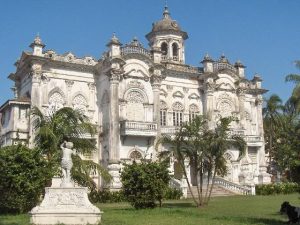
-
Mitford Hospital (Old Three Buildings)
-
Established: 1858.
-
Founder: Built by the British colonial government.
-
Main Attraction: It is one of the oldest medical institutions in Dhaka and reflects the early advancements in healthcare.
-
Specification: The hospital features colonial-era architecture with large verandas, tall windows, and red-brick facades.
-
Location: Located near the Mitford area of Old Dhaka, near the Sadarghat region.
-
Weiz House (Weisghat)
-
Established: 19th century.
-
Founder: The building was constructed by a European merchant family.
-
Main Attraction: Known for its historical significance in the colonial period as a residence for European traders.
-
Specification: The house showcases colonial architectural features, with large windows, arches, and a spacious verandah.
-
Location: Located in the Weisghat area of Old Dhaka.
-
Rose Garden Mansion
-
Established: Late 19th century.
-
Founder: Built by a prominent merchant family during the colonial era.
-
Main Attraction: The mansion is famous for its grand architecture and lush rose gardens, which were a notable feature of the estate.
-
Specification: The mansion combines both Mughal and European architectural styles, with ornate carvings and intricate detailing.
-
Location: Situated in the Wari area of Old Dhaka.
-
Shankhanidi Palace
-
Established: 19th century.
-
Founder: Built by a wealthy merchant family.
-
Main Attraction: Known for its lavishness and grandeur, the palace is a fine example of the aristocratic lifestyle during the colonial era.
-
Specification: The palace displays a blend of Mughal and European architectural styles with large rooms and decorative elements.
-
Location: Located in the old part of Dhaka, near the central regions.
-
Iskon Mandir
-
Established: 1996.
-
Founder: The International Society for Krishna Consciousness (ISKCON).
-
Main Attraction: A temple dedicated to Lord Krishna and the practice of Bhakti Yoga, known for its serene and spiritual atmosphere.
-
Specification: The temple is beautifully decorated with images of Lord Krishna, his consort Radha, and other deities.
-
Location: Situated in the Bakshi Bazar area of Dhaka.
-
St. Gregory’s School
-
Established: 1956.
-
Founder: The Roman Catholic Church.
-
Main Attraction: A historically significant school that has contributed to the educational development of Dhaka’s Christian community.
-
Specification: The school features colonial architectural elements, with spacious buildings and large windows.
-
Location: Located in the Farmgate area of Dhaka.
-
Pogose School
-
Established: 1902.
-
Founder: Named after Sir Pogose, an educational reformer.
-
Main Attraction: Known for its early contributions to the education of children in Dhaka, especially in the early 20th century.
-
Specification: The school’s building is an example of the colonial educational architecture, with large classrooms and spacious grounds.
-
Location: Situated in the old part of Dhaka, near the Lalbagh area.
-
Manuk House (Bangha Bhaban)
-
Established: 19th century.
-
Founder: Built by a prominent merchant family.
-
Main Attraction: Known for its beautiful architecture and the rich cultural history tied to the merchant class of Dhaka.
-
Specification: The building features colonial-era elements with intricate woodwork, high ceilings, and large verandas.
-
Location: Located in the central area of Dhaka.
-
Balda Garden
-
Established: 1917.
-
Founder: Built by the renowned philanthropist Balda family.
-
Main Attraction: The garden is famous for its lush greenery, serene environment, and historic significance as a private garden.
-
Specification: Features European and Mughal landscaping styles with manicured lawns and walking paths.
-
Location: Located in the Wari area of Dhaka.
-
Jagannath University Admin Building
-
Established: 1858 (as Dhaka College; became Jagannath University in 2005).
-
Founder: The building was part of Dhaka College, founded by the British colonial administration.
-
Main Attraction: The building is significant for its contribution to education and houses the administrative offices of Jagannath University.
-
Specification: The building features colonial architectural styles with large windows, high ceilings, and spacious corridors.
-
Location: Situated near the Old Dhaka area, close to the riverfront.
-
Buildings at Plots 7-9 (Koilash Ghosh Lane)
-
Established: 19th century.
-
Founder: Built during the colonial era by local aristocrats and traders.
-
Main Attraction: These buildings showcase Dhaka’s colonial residential architecture and urban planning.
-
Specification: The buildings feature traditional elements of colonial architecture, including large windows and verandas.
-
Location: Located in the old parts of Dhaka, near the Kotwali region.
-
Building No. 28 (Utsob Poddar Lane)
-
Established: Early 20th century.
-
Founder: Built by a wealthy merchant family during the colonial era.
-
Main Attraction: The building is notable for its residential architectural style and its historical value.
-
Specification: The house features colonial-style architecture, with a blend of European and Bengali influences.
-
Location: Situated in Utsob Poddar Lane in Old Dhaka.
-
Buildings No. 8, 8/1, 8/2 (Jhulan Bari Lane)
-
Established: 19th century.
-
Founder: Built by prominent local families during the colonial period.
-
Main Attraction: These buildings are known for their well-preserved colonial-era architecture.
-
Specification: The buildings include large courtyards, open verandas, and traditional colonial construction features.
-
Location: Located in the Jhulan Bari Lane area of Old Dhaka.
-
Dhaka Medical College (Arts Building, Hospital Building, Gate Houses)
-
Established: 1946.
-
Founder: The British colonial government, which founded Dhaka Medical College.
-
Main Attraction: It is one of the oldest medical institutions in Bangladesh, contributing to medical education and healthcare.
-
Specification: The complex features colonial-era buildings with large lecture halls, clinics, and old administrative blocks.
-
Location: Located in the Fulbaria area of Dhaka.
-
Dhaka University Campus: Vice Chancellor’s Residence
-
Established: 1920s.
-
Founder: The residence was built for the Vice Chancellor of Dhaka University during British rule.
-
Main Attraction: A grand colonial-style residence, reflecting the importance of the Vice Chancellor’s role in Dhaka University’s development.
-
Specification: The building has a blend of Mughal and British colonial design elements.
-
Location: Situated in the Dhaka University campus, near the central library.
-
Madhur Canteen
-
Established: 1950s.
-
Founder: The canteen was established by the Dhaka University authorities.
-
Main Attraction: Famous for being a historical meeting place for students and intellectuals, especially during the Language Movement.
-
Specification: The canteen is simple but historically significant, often frequented by students and political activists.
-
Location: Located inside the Dhaka University campus.
-
Twin Hindu Math (TSC)
-
Established: 1920s.
-
Founder: Built by the local Hindu community.
-
Main Attraction: It is a religious and cultural site for Hindus within Dhaka University, where students can engage in worship and community activities.
-
Specification: The structure is designed in traditional Hindu temple style with idols and religious symbols.
-
Location: Situated at the heart of the Dhaka University campus.
-
Curzon Hall
-
Established: 1904.
-
Founder: Named after Lord Curzon, the British Viceroy of India.
-
Main Attraction: A prominent building for Dhaka University’s science departments, known for its historical value and grand design.
-
Specification: The hall features neo-Gothic architecture, with tall spires and a large central hall for lectures and events.
-
Location: Located in the Dhaka University campus.
-
FH Hall
-
Established: 1927.
-
Founder: Part of Dhaka University, named after Sir Frank Heath.
-
Main Attraction: The hall is historically significant as a student dormitory that has been central to student life at Dhaka University.
-
Specification: The building has a simple, functional design typical of the colonial-era student halls.
-
Location: Situated in the Dhaka University campus.
-
SM Hall at DU
-
Established: 1948.
-
Founder: Built by the authorities of Dhaka University.
-
Main Attraction: SM Hall is one of the oldest residential halls at Dhaka University and is known for its role in student activism.
-
Specification: The building is designed in the colonial style, featuring large rooms and open verandas.
-
Location: Located within the Dhaka University campus.
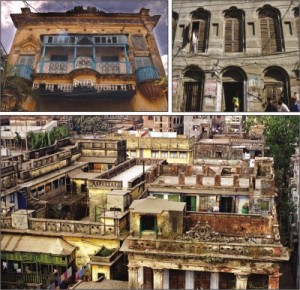
-
Jagannath Hall
-
Established: 1954.
-
Founder: Dhaka University authorities.
-
Main Attraction: One of the oldest residential halls in Dhaka University, central to student life and social activities.
-
Specification: The hall features traditional Bengali architectural styles combined with modern educational designs.
-
Location: Located within the Dhaka University campus.
-
Mir Jumla Gate (Dhaka Gate)
-
Established: 1660s.
-
Founder: Mir Jumla, the Mughal governor of Bengal.
-
Main Attraction: The gate was part of the defensive wall surrounding Dhaka during the Mughal era, symbolizing the city’s historical importance.
-
Specification: The gate is a beautiful example of Mughal military architecture, with thick walls and an imposing structure.
-
Location: Located near the entrance of Old Dhaka, near the Mirpur area.
-
Shikh Guru Duara
-
Established: 16th century.
-
Founder: Sikh religious community.
-
Main Attraction: This place of worship is significant for the Sikh community in Dhaka and represents their historical presence in the city.
-
Specification: The architecture is simple yet elegant, reflecting traditional Sikh design with a large central dome.
-
Location: Situated in the Old Dhaka area, near the Lalbagh region.
-
Greek Memorial
-
Established: 1857.
-
Founder: Greek community in Dhaka.
-
Main Attraction: The memorial commemorates the contribution of the Greek community during the British era, especially in the field of trade and culture.
-
Specification: The memorial includes inscriptions and symbolic elements commemorating Greek merchants in Dhaka.
-
Location: Located in the central area of Dhaka.
-
Burdwan House (Bangla Academy)
-
Established: 19th century.
-
Founder: Built by the Burdwan family, later became the home of Bangla Academy.
-
Main Attraction: The house is a mix of colonial and traditional Bengali architecture, housing the Bangla Academy, which promotes Bengali literature.
-
Specification: Features a blend of colonial-style brickwork and traditional Bengali architecture.
-
Location: Located near the Mohammadpur area in Dhaka.
-
Faculty of Fine Arts (Art College)
-
Established: 1948.
-
Founder: Part of Dhaka University, developed after the partition of Bengal.
-
Main Attraction: A hub for arts and culture in Dhaka, educating artists and fostering creative expression in Bangladesh.
-
Specification: The building showcases modernist architecture with a focus on creating a conducive environment for artistic development.
-
Location: Situated on the Dhaka University campus.
-
University Central Library
-
Established: 1955.
-
Founder: Dhaka University authorities.
-
Main Attraction: The central library is a major resource for students and scholars, with an extensive collection of books and archives.
-
Specification: The library features large reading rooms and modern facilities.
-
Location: Located on the Dhaka University campus.
-
Kendrio Shahid Minar
-
Established: 1952.
-
Founder: Designed by artist Hamidur Rahman.
-
Main Attraction: A national monument commemorating the martyrs of the 1952 Language Movement, which was central to the Bengali nationalist movement.
-
Specification: The monument features a unique design with tall pillars representing the struggle for the Bengali language.
-
Location: Situated near the Dhaka University campus, specifically in the Shahbagh area.
-
Mughal Eidgah (Dhanmondi)
-
Established: 17th century.
-
Founder: Built during the Mughal period.
-
Main Attraction: A historical mosque and prayer ground used for Eid prayers, one of the few remaining Mughal-period Eidgahs.
-
Specification: The structure features typical Mughal design elements, with large courtyards and arches.
-
Location: Located in the Dhanmondi area of Dhaka.
-
Satgambuj Mosque (Ahsan-Manzil)
-
Established: 17th century.
-
Founder: Built during the Mughal era by local nobles.
-
Main Attraction: The mosque is known for its elegant Mughal-style architecture and cultural importance.
-
Specification: The mosque features large domes and intricate tilework.
-
Location: Situated near Ahsan Manzil in Old Dhaka.
-
Unknown Tomb at Banshbari (Mohammadpur)
-
Established: 17th century.
-
Founder: Unknown.
-
Main Attraction: The tomb is a significant historical site, though the identity of the person buried there remains unclear.
-
Specification: The tomb features traditional Mughal-style architecture with intricate carvings and geometric patterns.
-
Location: Located in the Mohammadpur area.
-
Shahbaz Khan Mosque and Tomb (Old High Court Area)
-
Established: 1679.
-
Founder: Built by Shahbaz Khan, a Mughal general.
-
Main Attraction: Known for its unique combination of mosque and tomb within the same complex.
-
Specification: Features a large dome and arches with intricate Mughal designs.
-
Location: Located near the Old High Court area in Dhaka.
-
Holy Rozario Church (Tejgaon)
-
Established: 1677.
-
Founder: The Roman Catholic Church.
-
Main Attraction: One of the oldest Catholic churches in Dhaka, famous for its beautiful architecture and historical significance.
-
Specification: The church features gothic-style architecture, with stained glass windows and high ceilings.
-
Location: Located in Tejgaon, Dhaka.
-
Dewanbari Complex and Mosque (Aminbazar)
-
Established: 17th century.
-
Founder: Built by Dewan family during the Mughal period.
-
Main Attraction: Known for its historical significance as a noble residence and place of worship.
-
Specification: The mosque is a fine example of Mughal-era architecture, with a simple but impressive structure.
-
Location: Situated in the Aminbazar area of Dhaka.
-
Ambar Shah Mosque (Karwan Bazar)
-
Established: 17th century.
-
Founder: Built by local nobles during the Mughal period.
-
Main Attraction: The mosque is important for its historical significance and role in the religious life of Old Dhaka.
-
Specification: The mosque features a large central dome and intricate tilework.
-
Location: Located in the Karwan Bazar area of Dhaka.
-
Bhuiyan Bari Mosque (Beraid)
-
Established: 17th century.
-
Founder: Built by the Bhuiyan family during the Mughal period.
-
Main Attraction: Known for its historical and religious significance, it remains an active place of worship.
-
Specification: The mosque features a traditional Mughal architectural style with arches and minarets.
-
Location: Located in the Beraid area of Dhaka.
-
Kalibari (Siddheswari)
-
Established: 17th century.
-
Founder: Hindu community in Dhaka.
-
Main Attraction: A major Hindu temple in Dhaka, dedicated to Goddess Kali.
-
Specification: The temple has a large idol of Kali and features typical Hindu temple architecture with vibrant decorations.
-
Location: Situated in the Siddheswari area of Dhaka.
-
Archbishop House and Church (Kakrail)
-
Established: 1950s.
-
Founder: The Roman Catholic Church.
-
Main Attraction: This church and residence serve as the headquarters of the Catholic community in Dhaka.
-
Specification: It features simple yet elegant church architecture and serves as a focal point for Catholic activities in the city.
-
Location: Located in the Kakrail area of Dhaka.
-
Race Course Gallery (Suhrawardy Udyan)
-
Established: Early 20th century.
-
Founder: British colonial administration.
-
Main Attraction: The gallery is part of the historic Suhrawardy Udyan, which hosted many political and cultural events.
-
Specification: It offers a colonial design with galleries and viewing spaces for public events.
-
Location: Located in Suhrawardy Udyan, near the Dhaka University campus.
-
Old High Court Building
-
Established: 1900s.
-
Founder: The British colonial administration.
-
Main Attraction: The Old High Court building is an iconic structure in the city’s colonial history, symbolizing the legal system.
-
Specification: Built in the neo-Gothic style, the building features arched windows, pointed spires, and large columns.
-
Location: Situated near the Paltan area in Dhaka.
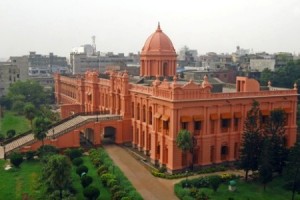
-
Chummery House (Topkhana Road)
-
Established: 19th century.
-
Founder: Built by a British official or merchant during the colonial era.
-
Main Attraction: Known for its colonial architectural features, including large windows, verandas, and a spacious front yard.
-
Specification: The house has a European-style design, with an emphasis on comfort and functionality.
-
Location: Located on Topkhana Road, in the central part of Dhaka.
-
Govt Employees Hospital (Fulbari)
-
Established: 1960s.
-
Founder: Government of Bangladesh.
-
Main Attraction: A prominent hospital established for the healthcare of government employees.
-
Specification: A significant building designed with practical and functional aspects for medical facilities.
-
Location: Located in the Fulbari area of Dhaka.
-
Rashid Bhaban (BUET)
-
Established: 1960s.
-
Founder: Built by the Bangladesh University of Engineering and Technology (BUET).
-
Main Attraction: A key building in the BUET campus that has contributed significantly to the development of engineering education in Bangladesh.
-
Specification: A modern structure with academic and administrative facilities.
-
Location: Situated within the BUET campus in Dhaka.
-
Foreign Ministry (Segunbagicha)
-
Established: 1980s.
-
Founder: Government of Bangladesh.
-
Main Attraction: The building houses the Ministry of Foreign Affairs of Bangladesh and plays a key role in the country’s diplomacy.
-
Specification: A modern government building designed with functionality and security in mind.
-
Location: Located in Segunbagicha, Dhaka.
-
Jatiya Sangsad Bhaban and Sher-e-Bangla Nagar Complex
-
Established: 1960s.
-
Founder: Designed by architect Louis Kahn.
-
Main Attraction: The Jatiya Sangsad Bhaban (National Parliament Building) is a significant symbol of Bangladesh’s democratic process.
-
Specification: The building features striking modernist architecture, with massive geometric forms and a unique use of concrete.
-
Location: Located in Sher-e-Bangla Nagar, Dhaka.
-
NAEM (Education Extension Centre, Dhanmondi)
-
Established: 1970s.
-
Founder: Government of Bangladesh.
-
Main Attraction: A significant educational building that serves as the hub for various educational activities and training programs in Bangladesh.
-
Specification: The building is functional, designed to accommodate educational seminars, workshops, and training sessions.
-
Location: Located in the Dhanmondi area of Dhaka.
-
Kamalapur Railway Station
-
Established: 1960s.
-
Founder: Built by the government of Bangladesh as a modern transport hub.
-
Main Attraction: The station serves as a primary railway terminal for Dhaka and is a key transportation link to other parts of the country.
-
Specification: The station building features modernist architecture and large platforms.
-
Location: Located in the Kamalapur area of Dhaka.
-
Residence No. 301-B (Road 24, Dhanmondi)
-
Established: Mid-20th century.
-
Founder: Built by a prominent local family.
-
Main Attraction: The building is an example of modern residential architecture in Dhaka during the mid-20th century.
-
Specification: Features spacious living areas and a large courtyard, typical of middle-class residential designs of the time.
-
Location: Located in Dhanmondi, Dhaka.
-
Shahid Buddijibi Smrithisoudha (Mirpur)
-
Established: 1971.
-
Founder: Government of Bangladesh.
-
Main Attraction: A memorial dedicated to the intellectuals who were martyred during the 1971 Liberation War.
-
Specification: The memorial features sculptures, plaques, and a serene environment to honor the martyrs.
-
Location: Situated in the Mirpur area of Dhaka.
-
Rayer Bazar Badya Bhumi Smriti Soudha
-
Established: 1971.
-
Founder: Government of Bangladesh.
-
Main Attraction: This site commemorates the victims of the Rayer Bazar mass killing during the 1971 Liberation War.
-
Specification: The memorial includes symbolic sculptures and memorial stones to honor the lives lost.
-
Location: Located in the Rayer Bazar area of Dhaka.
-
Bangabandhu Museum (Dhanmondi)
-
Established: 1997 (as a museum).
-
Founder: The museum is dedicated to the life and legacy of Sheikh Mujibur Rahman, the Father of the Nation.
-
Main Attraction: The museum is housed in Sheikh Mujibur Rahman’s former residence and contains numerous personal belongings, photographs, and historical artifacts.
-
Specification: The building is a historical landmark, showcasing the life of Bangladesh’s first president.
-
Location: Located in the Dhanmondi area of Dhaka.
-
Rajuk Bhaban
-
Established: 1980s.
-
Founder: Built by the Rajdhani Unnayan Kartripakkha (RAJUK), the urban development authority of Dhaka.
-
Main Attraction: The building houses the administrative functions related to Dhaka’s urban development and planning.
-
Specification: A modern government office building designed to accommodate urban planning functions.
-
Location: Situated in the central area of Dhaka.
-
Nagar Bhaban (DCC)
-
Established: 1990s.
-
Founder: Dhaka City Corporation (DCC).
-
Main Attraction: The headquarters of the Dhaka City Corporation, playing a vital role in the administration of Dhaka city.
-
Specification: A modern civic building designed to accommodate municipal functions and services.
-
Location: Located in the central area of Dhaka.
-
Hrishi Kesh Das Road
-
Established: 19th century.
-
Founder: Likely named after an important local figure, Hrishi Kesh Das.
-
Main Attraction: The road is known for its historical role in the commercial life of Old Dhaka.
-
Specification: The road features traditional colonial-era buildings and vibrant street life.
-
Location: Located in the old part of Dhaka.
-
Rebati Mohan Das Road
-
Established: 19th century.
-
Founder: Likely named after a notable local figure, Rebati Mohan Das.
-
Main Attraction: Known for its traditional architecture and vibrant cultural atmosphere.
-
Specification: The road features old colonial-era buildings, shops, and residential areas.
-
Location: Located in the central part of Dhaka.
-
BK Das Road
-
Established: 19th century.
-
Founder: Named after an important local figure or businessman, BK Das.
-
Main Attraction: The road has several significant buildings from the colonial era.
-
Specification: It is lined with old buildings that reflect the architectural trends of the British colonial period.
-
Location: Located in the central area of Dhaka.
-
Farashganj Road
-
Established: 19th century.
-
Founder: Built during the colonial period.
-
Main Attraction: A key road in the commercial center of Old Dhaka, known for its busy markets and historical buildings.
-
Specification: Features a mix of residential and commercial colonial-era buildings.
-
Location: Located in the Farashganj area of Old Dhaka.
-
Shakhari Bazar
-
Established: 17th century.
-
Founder: The area developed as a part of the growing settlement in Old Dhaka.
-
Main Attraction: A historic market area, Shakhari Bazar is known for its traditional architecture and bustling street life.
-
Specification: The area features narrow lanes and old buildings, many of which have preserved traditional architecture.
-
Location: Located in the heart of Old Dhaka.
-
Panitola (Shakharibazar)
-
Established: 17th century.
-
Founder: Established as a commercial area during the Mughal period.
-
Main Attraction: Known for its vibrant street market and historical significance.
-
Specification: Panitola retains many of its old buildings and street layouts from the Mughal era.
-
Location: Located in the Shakharibazar area of Old Dhaka.
-
Pyari Das Road
-
Established: 19th century.
-
Founder: Likely named after a local figure, Pyari Das.
-
Main Attraction: The road is a notable part of the commercial hub in Old Dhaka, with a mix of traditional buildings.
-
Specification: Features colonial-style buildings with intricate carvings and large windows.
-
Location: Located in the Sutrapur area of Old Dhaka.
The 100 heritage sites of Dhaka reflect the city’s continuous transformation while honoring its past. Whether it’s the majestic Mughal architecture, the British colonial influence, or the modern landmarks that symbolize the independent nation, these sites are a testament to Dhaka’s cultural, religious, and political significance. Many of these heritage sites, despite being less than 100 years old, continue to be integral to Dhaka’s identity, offering both residents and visitors a glimpse into the city’s complex historical narrative. Preserving and appreciating these sites ensures that future generations can continue to understand and celebrate the rich tapestry of Dhaka’s heritage.

